CHEVROLET CORVETTE 1996 4.G Manual Online
Manufacturer: CHEVROLET, Model Year: 1996, Model line: CORVETTE, Model: CHEVROLET CORVETTE 1996 4.GPages: 386, PDF Size: 20.12 MB
Page 81 of 386
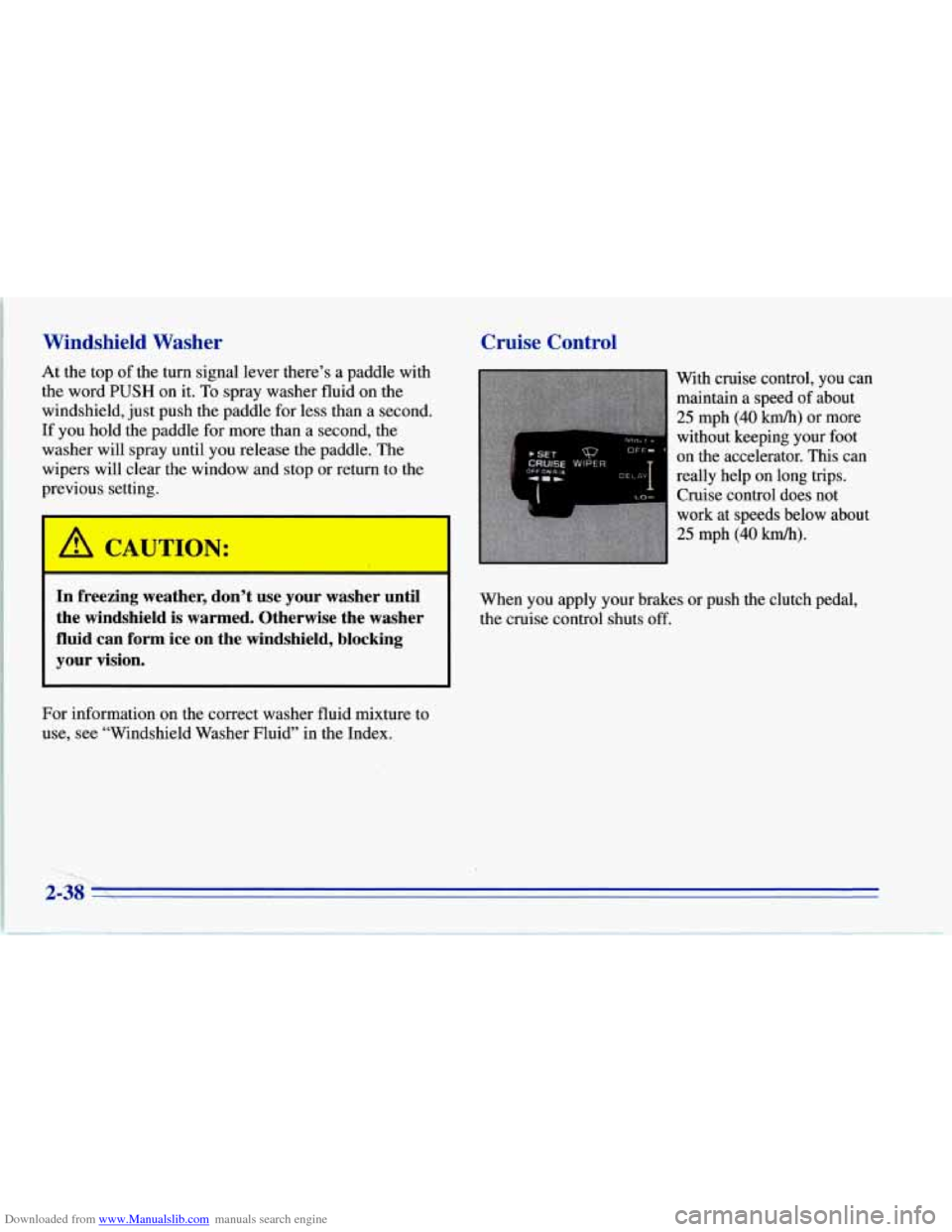
Downloaded from www.Manualslib.com manuals search engine Windshield Washer
At the top of the turn signal lever there’s a paddle with
the word
PUSH on it. To spray washer fluid on the
windshield, just push the paddle for less than a second.
If you hold the paddle for more than a second, the
washer will spray until you release the paddle. The
wipers will clear the window and stop
or return to the
previous setting.
c
In freezing weather, don’t use your washer until
the windshield is warmed. Otherwise the washer
fluid can form ice on the windshield, blocking
your vision.
For information on the correct washer fluid mixture to
use, see “Windshield Washer Fluid” in the Index.
Cruise Control
t LU-
With cruise control, you can
maintain a speed of about
25 mph (40 km/h) or more
without keeping your foot
on the accelerator. This can
really help on long trips.
Cruise control does not
work at speeds below about
25 mph (40 km/h).
When you apply your brakes or push the clutch pedal,
the cruise control shuts
off.
Page 82 of 386
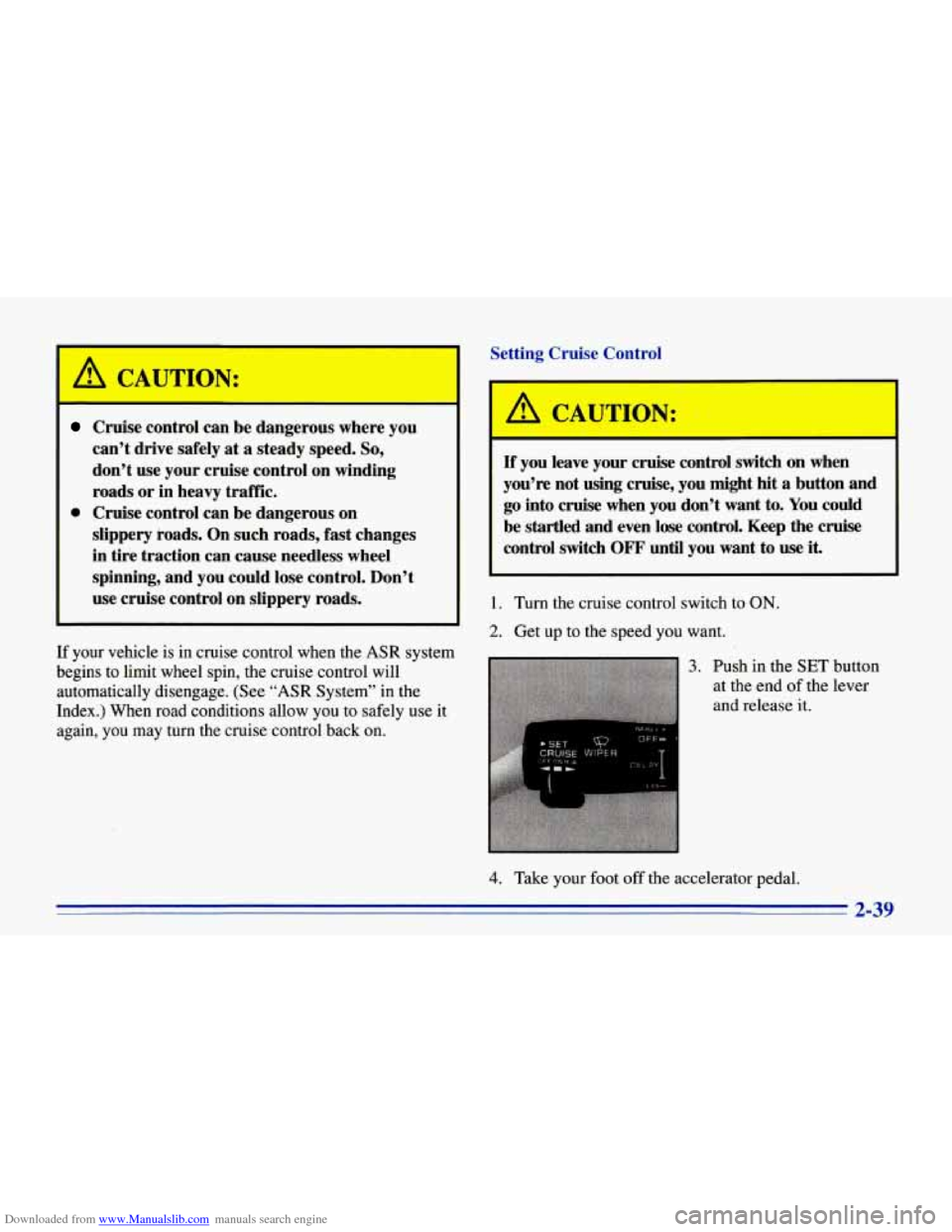
Downloaded from www.Manualslib.com manuals search engine 1
I A CAUTION:
Cruise control can be dangerous where you
can’t drive safely at
a steady speed. So,
don’t use your cruise control on winding
roads or in heavy traffic.
slippery roads. On such roads, fast changes
in tire traction can cause needless wheel
spinning, and you could lose control. Don’t
use cruise control on slippery roads.
0 Cruise control can be dangerous on
If your vehicle is in cruise control when the ASR system
begins
to limit wheel spin, the cruise control will
automatically disengage. (See
“ASR System” in the
Index.) When road conditions allow you to safely use it
again, you may turn the cruise control back on.
Setting Cruise Contra1
If you leave your cruise control switch on when
you’re not using cruise,
you might hit a button and
go
into cruise when you don’t want to. You could
be startled and even lose control. Keep the cruise
control switch
OFF until you want to use it.
1. Turn the cruise control switch to ON.
2. Get up to the speed you want.
3. Push in the SET button
at the end
of the lever
and release
it.
4. Take your foot off the accelerator pedal.
2-39
Page 83 of 386
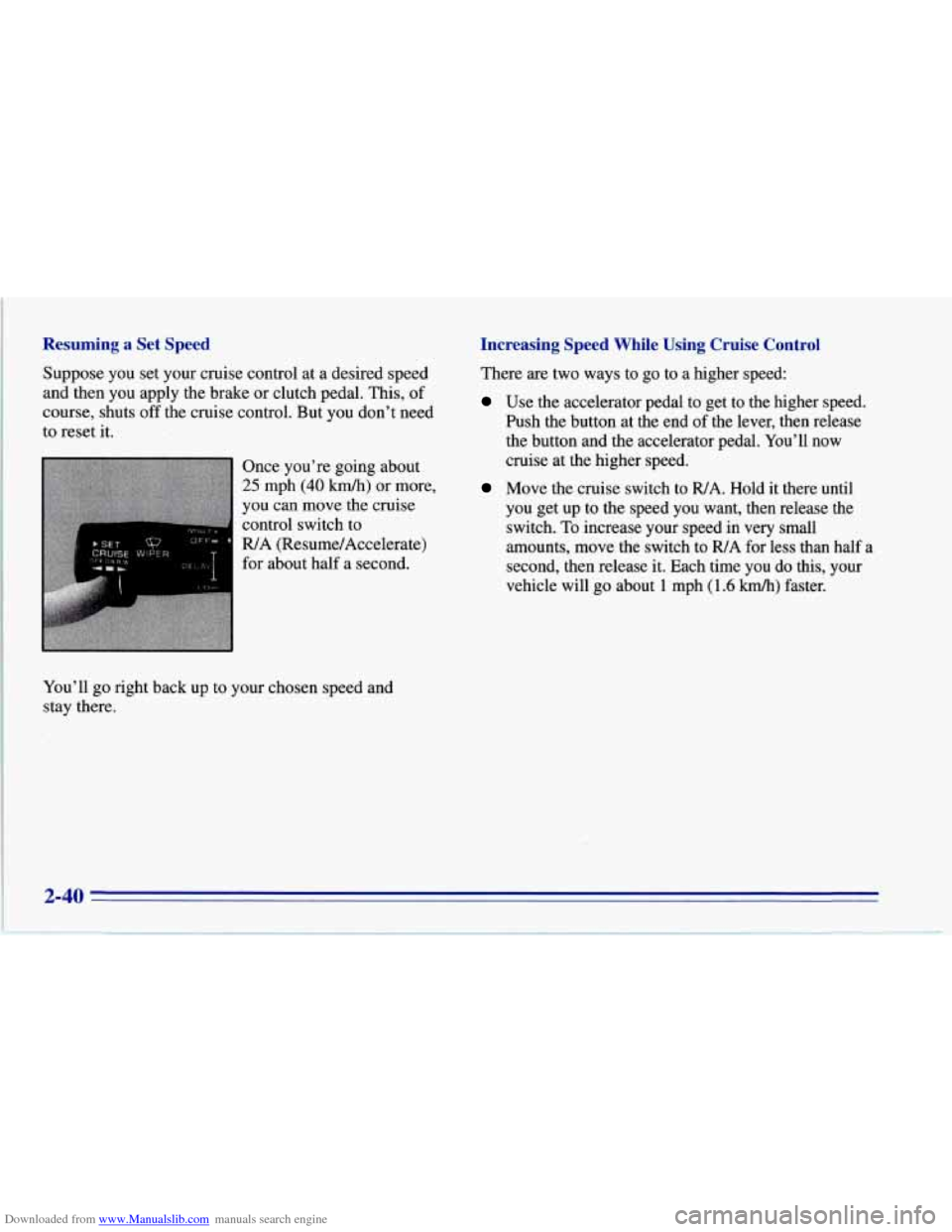
Downloaded from www.Manualslib.com manuals search engine Resuming a Set Speed
Suppose you set your cruise control at a desired speed
and then you apply the brake or clutch pedal. This,
of
course, shuts off the cruise control. But you don't need
to reset it.
Once you're going about
25 mph (40 kmih) or more,
you can move the cruise
control switch to
FUA (Resume/Accelerate)
for about half a second.
You'll go right back up to your chosen speed and
stay there.
Increasing Speed While Using Cruise Control
There are two ways to go to a higher speed:
Use the accelerator pedal to get to the higher speed.
Push the button at the end of the lever, then release
the button and the accelerator pedal. You'll now
cruise at the higher speed.
Move the cruise switch to R/A. Hold it there until
you get up to the speed you want, then release the
switch.
To increase your speed in very small
amounts, move the switch to
R/A for less than half a
second, then release it. Each time you do this, your
vehicle will
go about 1 mph (1.6 km/h) faster.
Page 84 of 386
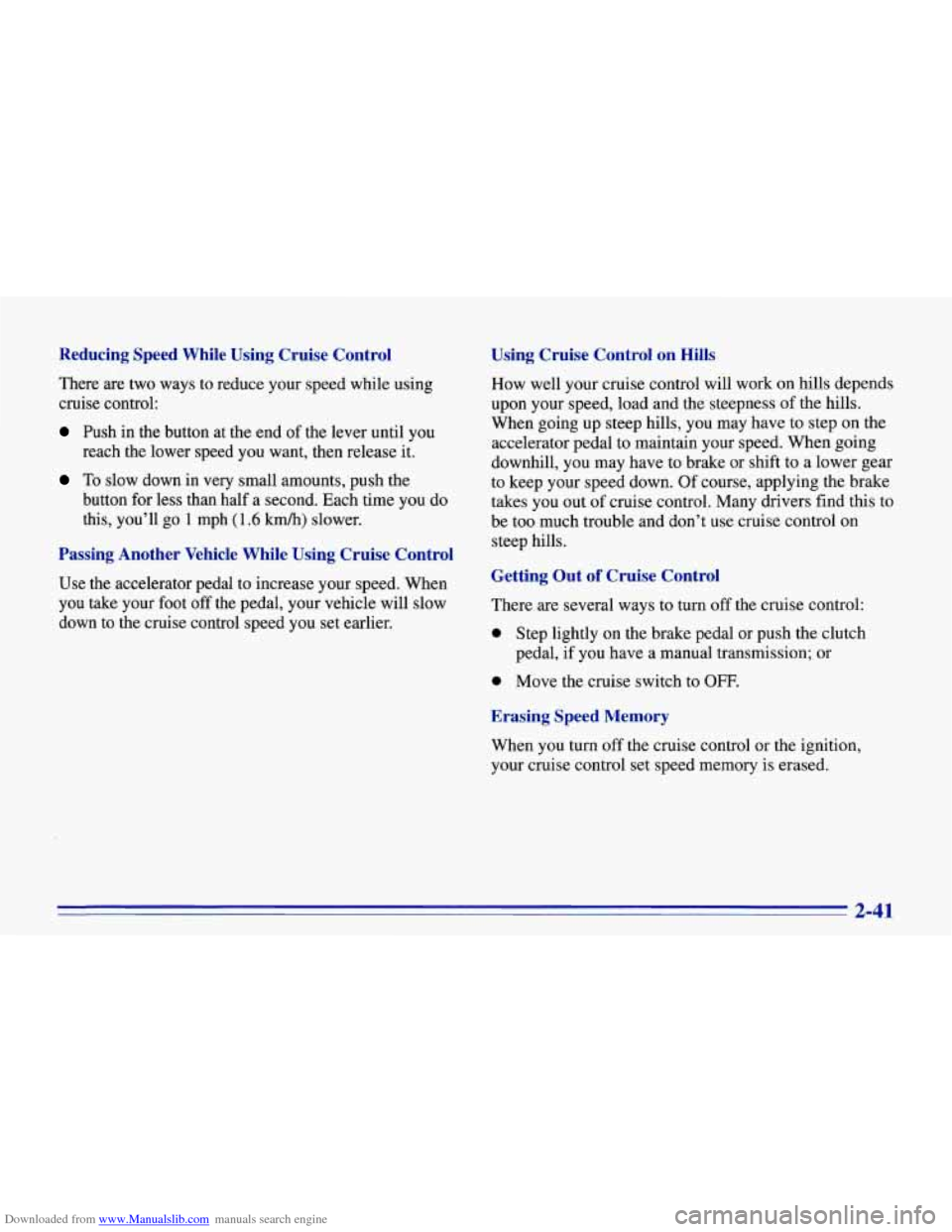
Downloaded from www.Manualslib.com manuals search engine Reducing Speed While Using Cruise Control
There are two ways to reduce your speed while using
cruise control:
Push in the button at the end of the lever until you
reach the lower speed you want, then release it.
To slow down in very small amounts, push the
button for less than half a second. Each time you
do
this, you’ll go 1 mph (1.6 km/h) slower.
Passing Another Vehicle While Using Cruise Control
Use the accelerator pedal to increase your speed. When
you take your foot
off the pedal, your vehicle will slow
down to the cruise control speed you set earlier.
Using Cruise Control on Hills
How well your cruise control will work on hills depends
upon your speed, load and the steepness of the hills.
When going up steep hills, you may have to step on the
accelerator pedal to maintain your speed. When going
downhill, you may have to brake or shift to a lower gear
to keep your speed down. Of course, applying the brake
takes you out
of cruise control. Many drivers find this to
be too much trouble and don’t use cruise control on
steep hills.
Getting Out of Cruise Control
There are several ways to turn off the cruise control:
0 Step lightly on the brake pedal or push the clutch
pedal, if you have a manual transmission; or
0 Move the cruise switch to OFF.
Erasing Speed Memory
When you turn off the cruise control or the ignition,
your cruise control set speed memory is erased.
2-41
Page 85 of 386
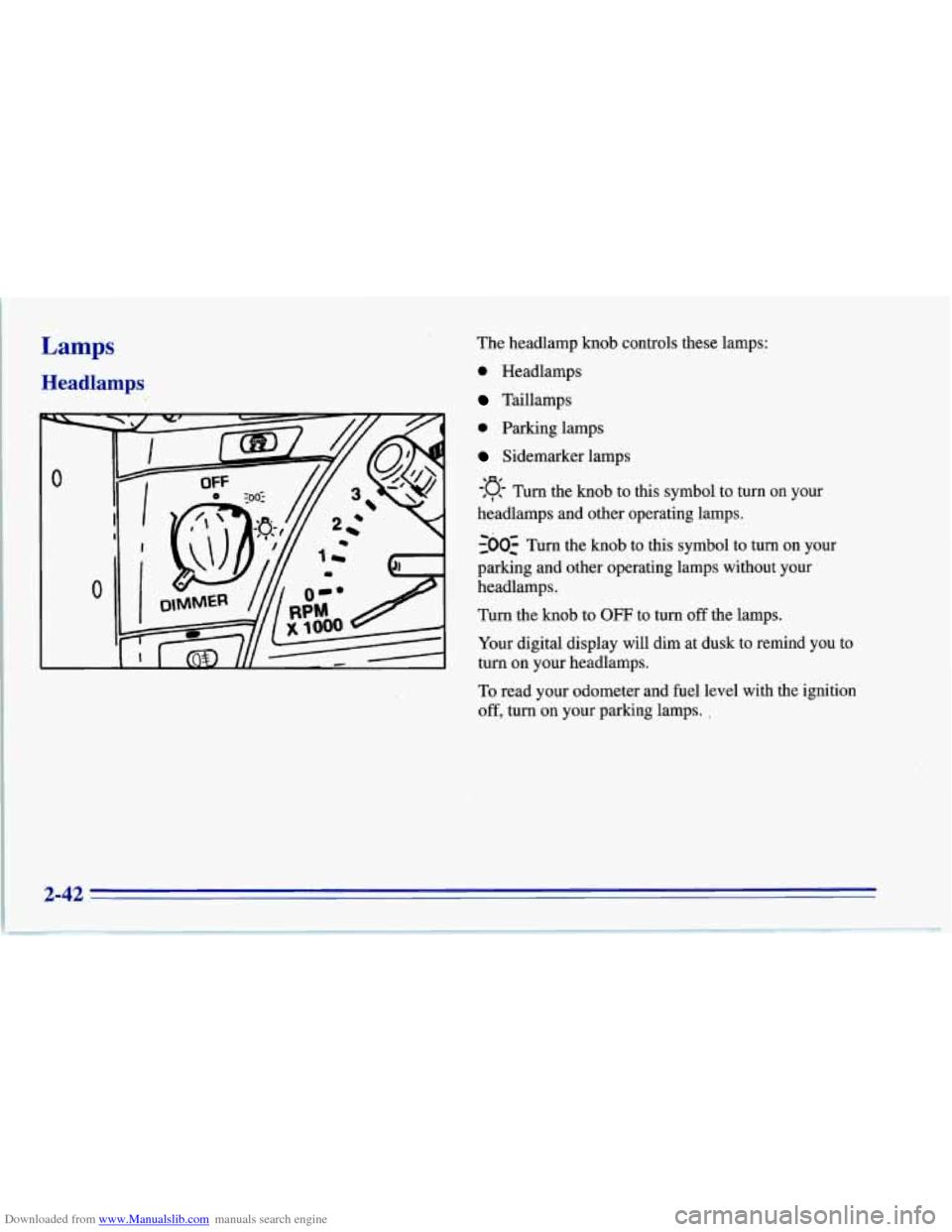
Downloaded from www.Manualslib.com manuals search engine Lamps
Headlamps
The headlamp knob controls these lamps:
0 Headlamps
Taillamps -
0 Parking lamps
Sidemarker lamps
-g- Turn the knob to this symbol to turn on your
headlamps and other operating lamps.
Turn the knob to this symbol to turn on your
parking and other operating lamps without your
headlamps.
Turn the knob to
OFF to turn off the lamps.
Your digital display will dim at dusk to remind you'to
turn on your headlamps.
To read your odometer and fuel level with the ignition
off, turn on your parking lamps. ,
Page 86 of 386
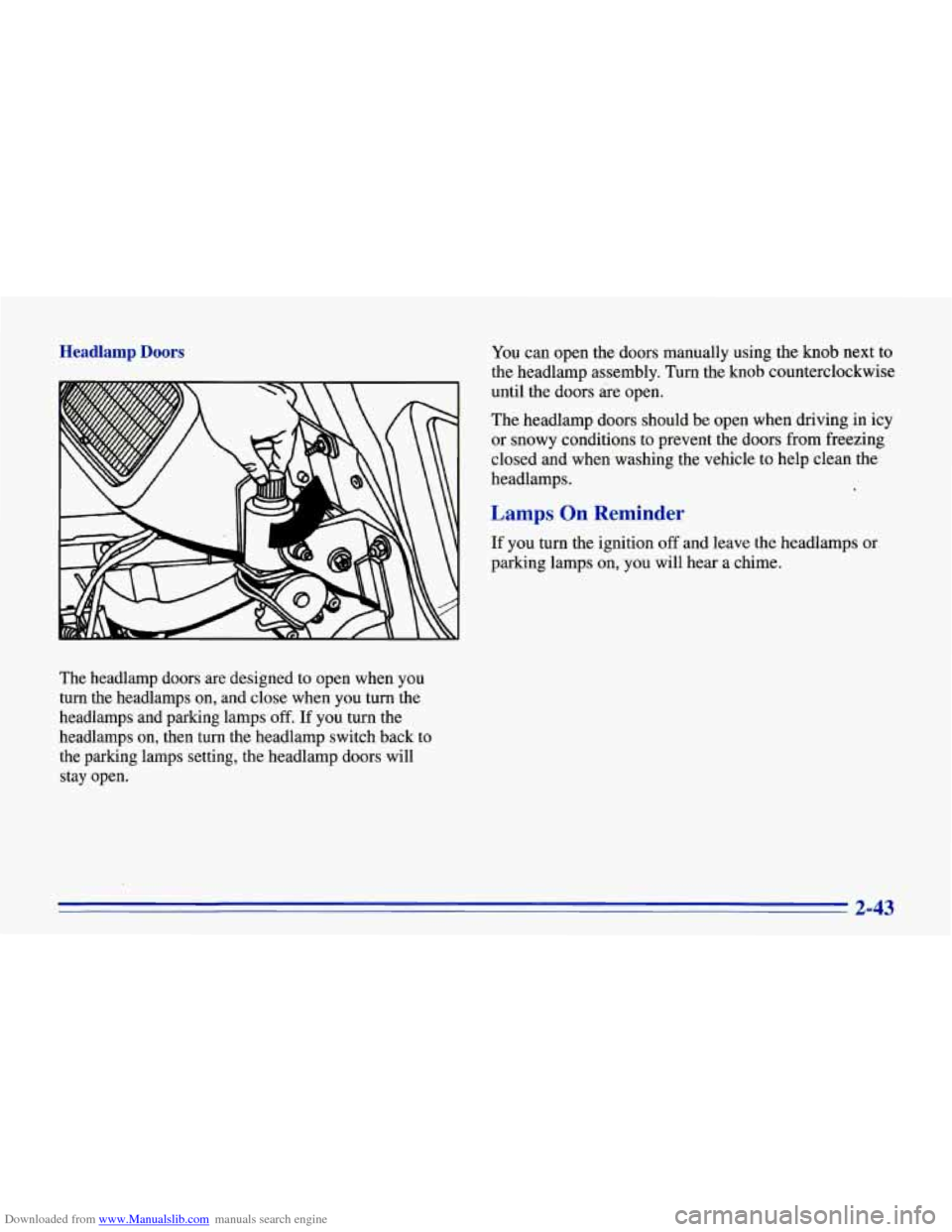
Downloaded from www.Manualslib.com manuals search engine Headlamp Doors
The headlamp doors are designed to open when you
turn the headlamps on, and close when you turn the
headlamps and parking lamps off.
If you turn the
headlamps on, then turn the headlamp switch back to
the parking lamps setting, the headlamp doors will
stay open. You
can open the doors manually using the knob next to
the headlamp assembly. Turn the knob counterclockwise
until the doors are open.
The headlamp doors should be open when driving in icy
or snowy conditions to prevent the doors from freezing
closed and when washing the vehicle to help clean the
headlamps
.
Lamps On Reminder
If you turn the ignition off and leave the headlamps or
parking lamps on, you will hear a chime.
2-43
Page 87 of 386
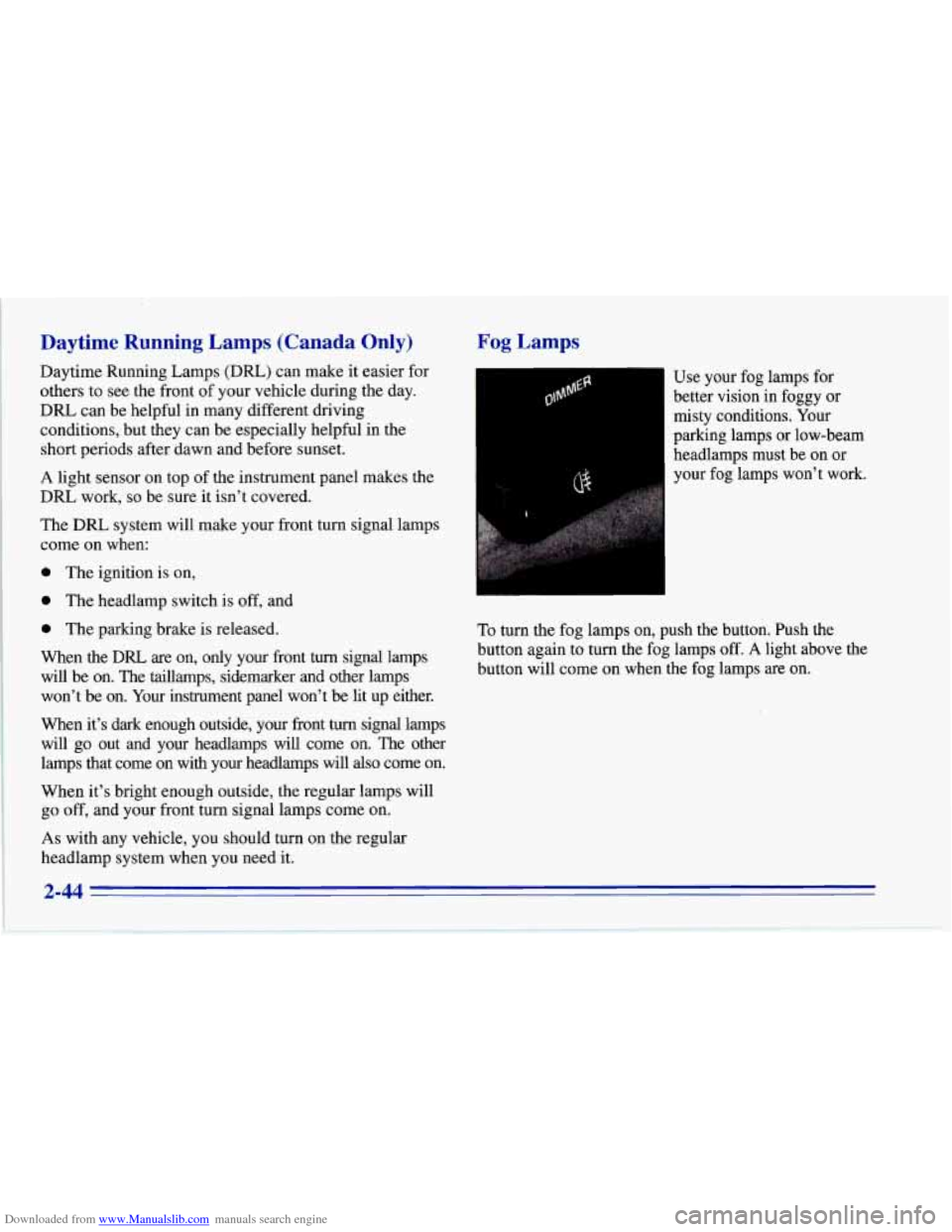
Downloaded from www.Manualslib.com manuals search engine Daytime Running Lamps (Canada Only)
Daytime Running Lamps (Dm) can make it easier for
others to see the front of your vehicle during the day.
DRL can be helpful in many different driving
conditions, but they can be especially helpful in the
short periods after dawn and before sunset.
A light sensor on top of the instrument panel makes the
DRL work,
so be sure it isn’t covered.
The DlU system will make your front turn signal lamps
come on when:
0 The ignition is on,
0 The headlamp switch is off, and
0 The parking brake is released.
When
the DRL are on, only your front turn signal lamps
will be on. The taillamps, sidemarker and other lamps won’t be on. Your instrument panel won’t
be lit up either.
When it’s dark enough outside, your front
turn signal lamps
will go out and your headlamps will come on. The other
lamps that come on with your headlamps will
also come on.
When it’s bright enough outside, the regular lamps will
go
off, and your front turn signal lamps come on.
As with any vehicle, you should turn on the regular
headlamp system when you need it.
Fog Lamps
I-1 Use your fog lamps for
better vision in foggy or
misty conditions. Your
parking lamps or low-beam
headlamps must be on or
your fog lamps won’t work.
To turn the fog lamps on, push the button. Push the
button again to turn the fog lamps
off. A light above the
button will come on when the fog lamps are on.
2-44
Page 88 of 386
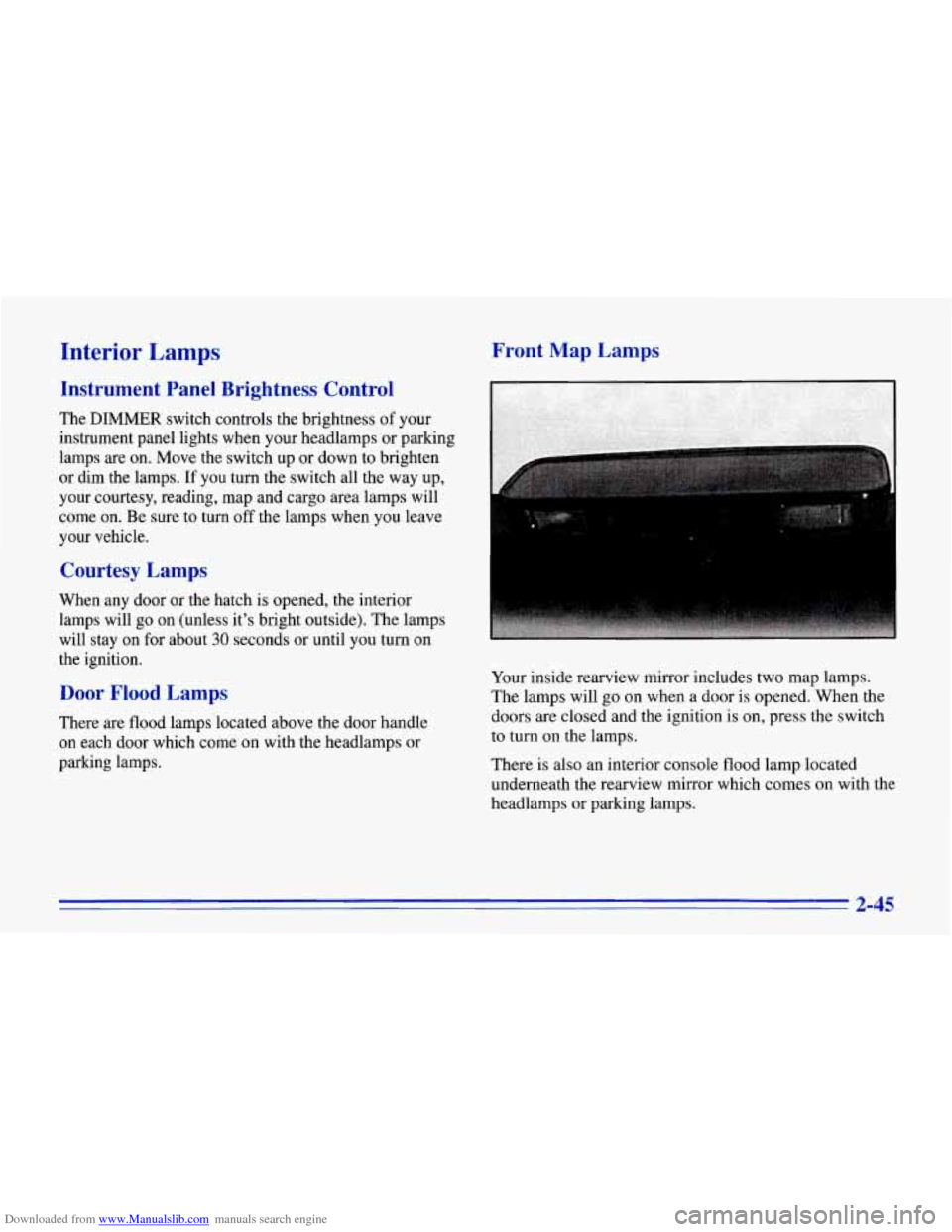
Downloaded from www.Manualslib.com manuals search engine Interior Lamps
Instrument Panel Brightness Control
The DIMMER switch controls the brightness of your
instrument panel lights when your headlamps or parking
lamps are on. Move the switch up or down to brighten
or dim the lamps.
If you turn the switch all the way up,
your courtesy, reading, map and cargo area lamps will
come on. Be sure to turn
off the lamps when you leave
your vehicle.
Courtesy Lamps
When any door or the hatch is opened, the interior
lamps will go on (unless it's bright outside). The lamps
will stay on for about
30 seconds or until you turn on
the ignition.
Door Flood Lamps
There are flood lamps located above the door handle
on each door which come on with the headlamps or
parking lamps.
Front Map Lamps
.. .. .. .. . '
Your inside rearview mirror includes two map lamps.
The lamps will go on when a door
is opened. When the
doors are closed and the ignition is on, press the switch
to turn
on the lamps.
There is also an interior console flood lamp located
underneath the rearview mirror which comes on with the
headlamps or parking lamps.
2-45
Page 89 of 386
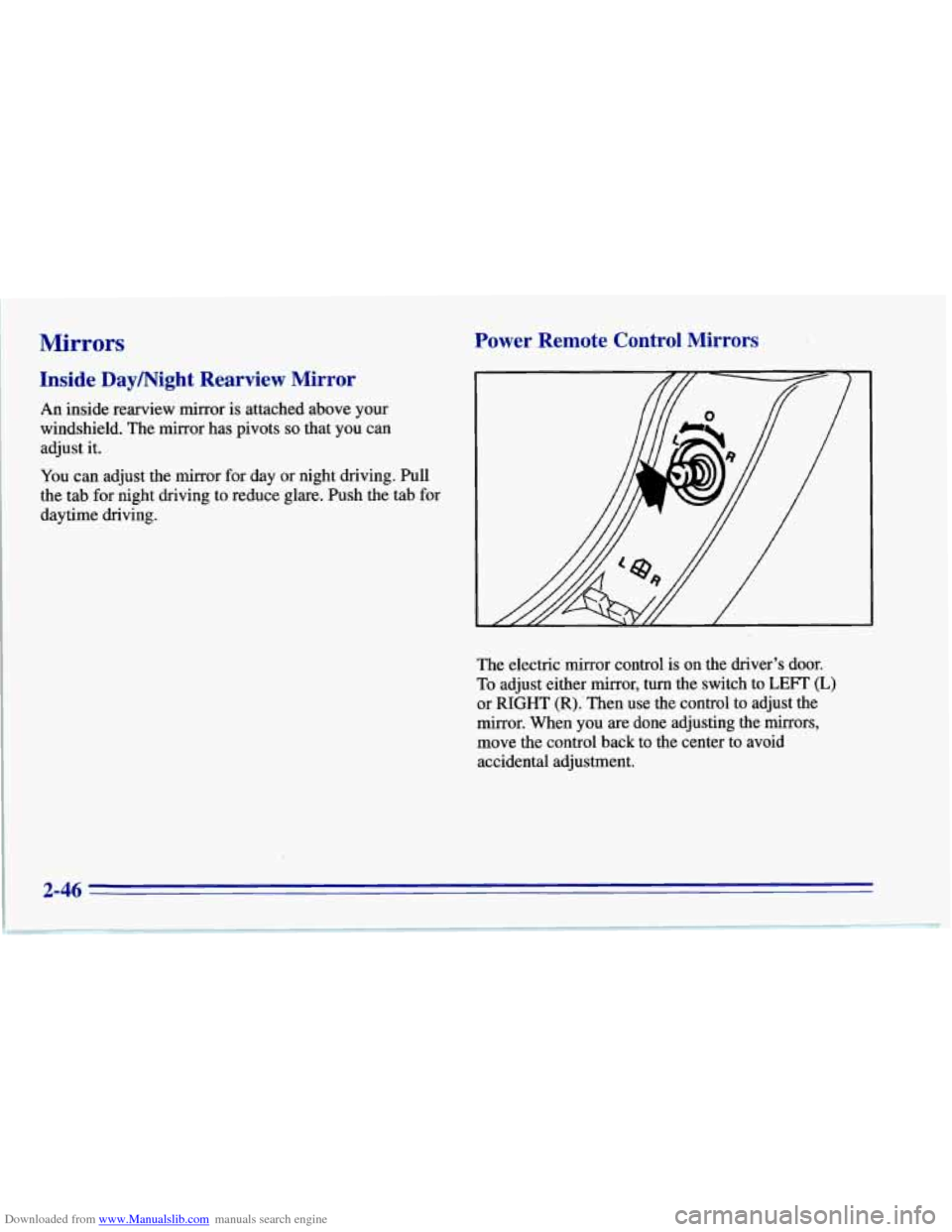
Downloaded from www.Manualslib.com manuals search engine Mirrors
Inside Daymight Rearview Mirror
An inside rearview mirror is attached above your
windshield. The mirror has pivots
so that you can
adjust it.
You can adjust the mirror for day or night driving. Pull
the tab for night driving to reduce glare. Push the tab for
daytime driving.
Power Remote Control Mirrors
The electric mirror control is on the driver's door.
To adjust either mirror, turn the switch to LEFT (L)
or RIGHT (R).'Then use the control to adjust the
mirror. When you
are done adjusting the mirrors,
move the control back to the center to avoid
accidental adjustment.
2-46
Page 90 of 386
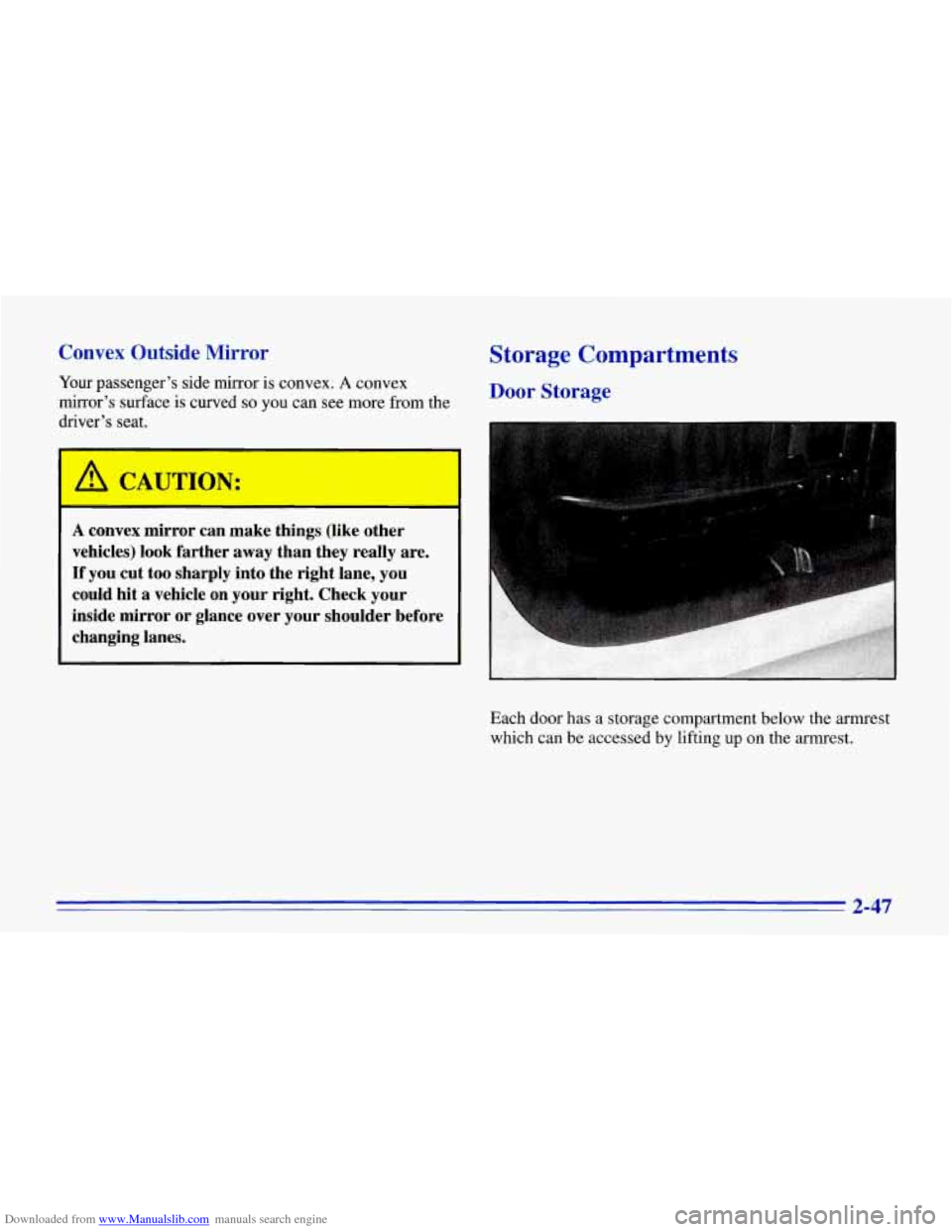
Downloaded from www.Manualslib.com manuals search engine Convex Outside Mirror
Your passenger’s side mirror is convex. A convex
mirror’s surface is curved
so you can see more from the
driver’s seat.
A CAUTION:
A convex mirror can make things (like other
vehicles) look farther away than they really are.
If you cut
too sharply into the right lane, you
could hit a vehicle on your right. Check your
inside mirror or glance over your shoulder before
changing lanes.
Each door has a storage compartment below the armrest
which can be accessed
by lifting up on the armrest.
2-47